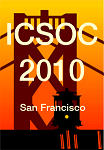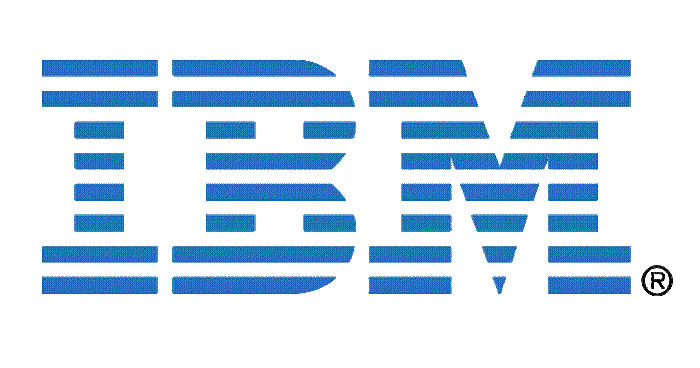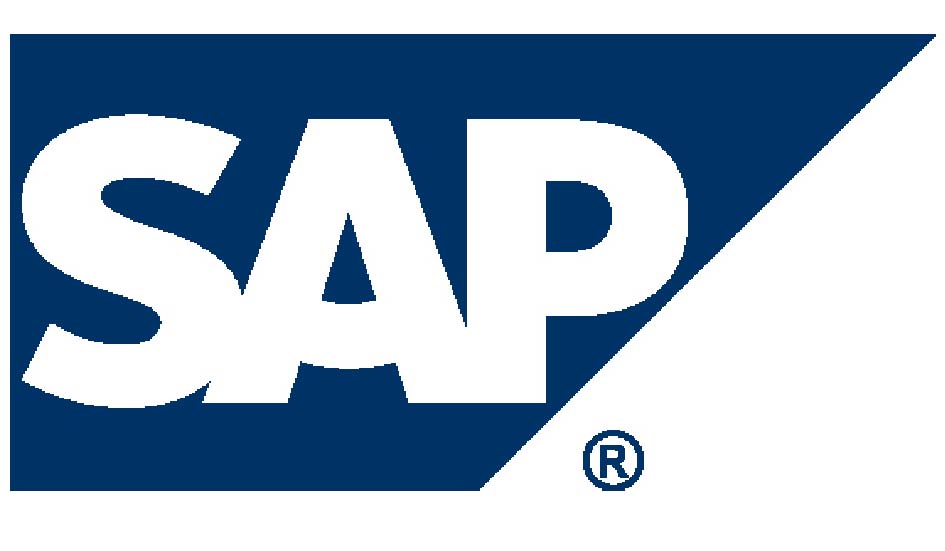
The Eighth International Conference on Service Oriented Computing
December 7-10, 2010, San Francisco, California
Tutorials
- Multidisciplinary Views of Business Contract - M. P. Singh, N. Desai
- Quantitative Service Analysis - N. Kulkarni, D. Parachuri and S. Trivedi
- Scalable Services: Understanding Architecture Trade-off - S. Tai, M. Klems
- Crowd-driven processes: state of the art and research challenges - M. Vukovic, C. Bartolini
Multidisciplinary Views of Business Contracts
Author Name 1: Munindar P. Singh
Professor, Department of Computer Science, North Carolina State University
Author Name 2: Nirmit Desai
Research Staff Member, IBM Research, India
Abstract:
Several major trends in the services industry drive toward an increasing importance of contracts. These include the formalization of business processes across the client and the provider organizations; resource administration in the cloud computing environments; service-level agreements as they arise in infrastructure and networking services; and services viewed from the perspective of real-life engagements.
Previous work on e-commerce architectures and on technical services (such as web and grid services) has focused on low-level aspects of computation. In contrast, the emerging trend toward contracts recognizes the importance of high-level, flexible specifications of interactions. It is clear that contracts make sense only when the contracting parties are autonomous. Further, contracts help shield the organizational heterogeneity of the contracting parties from one another. In this manner, contracts provide a natural match for a variety of real-world problems that service scientists are beginning to recognize.
By developing and studying the contracts from perspectives of multi-agent systems, legal and jurisprudence literature, and economics, we would not only find compelling new applications for the concepts and techniques of multi-agent systems but also discover new and multidisciplinary methods driven by contracts for architecting service systems.
This tutorial introduces the key ideas and techniques of contracts as they arise in major real-world service engagements; the benefits of formalizing contracts to realize them computationally; and the opportunities and challenges contracts offer for researchers and practitioners. We are seeing increasing interest in contracts from the services research community. Recently, several high-profile research projects have been centered on contracts. While most members of the ICSOC community may be familiar with WS-Agreement, Service-Level, Agreements, and Quality of Service, the attendees may benefit from alternative, multidisciplinary, perspectives into contracts such as theory and practice of multi-agent systems, legal and jurisprudence literatures, and ideas from social sciences and economics. The tutorial would enable the studies of contracts by understanding why contracts are needed, how they can be represented, and which concepts and techniques support contracts naturally. This tutorial will provide the key background, which attendees can use as a launching pad for their investigations.
This tutorial is presented at a senior undergraduate student level. It is accessible to developers from industry and to students. Typical attendees for our past tutorials have been researchers and practitioners from industry and government, developers, graduate and senior undergraduate students, and university faculty.
About the Speakers:
Speaker 1:
Munindar is a full professor in the department of computer science at North Carolina State University. From 1989 through 1995, he was with the Microelectronics and Computer Technology Corporation. Munindar's research interests include multi-agent systems and Web services, where he specifically addresses the challenges of trust, service discovery, and business processes and protocols in large-scale open environments.
Munindar's 1994 book Multi-agent Systems, was published by Springer-Verlag. Munindar edited the Practical Handbook of Internet Computing, published by CRC Press in 2004. With Mike Huhns, he co-edited Readings in Agents (published by Morgan Kaufmann in 1998), and coauthored a textbook Service-Oriented Computing: Semantics, Processes, Agents (published by Wiley in 2005).
Munindar was the EIC of IEEE Internet Computing from 1999 to 2002 and continues to serve on its editorial board. He is also a founding member of the editorial boards of the Journal of Autonomous Agents and Multi-agent Systems and the Journal of Web Semantics. In 2005, he was general co-chair for the International Joint Conference on Autonomous Agents and Multi-agent Systems.
Munindar's research has been recognized with awards from the Army Research Office, Cisco Systems, DARPA, Ericsson, IBM, Intel, and the National Science Foundation.
Munindar obtained a B.Tech. in CSE from IIT-Delhi in 1986 and a Ph.D. in Computer Sciences from the University of Texas at Austin in 1993.
Munindar has a substantial track-record in the theory and practice of large-scale software systems, and has been actively studying contracts in research projects. He also has extensive experience in teaching and in making tutorial presentations. Specifically, he has given graduate courses related to this tutorial, has presented tutorials at a number of international conferences, and has led discussions involving the concepts and techniques to be described.
Speaker 2:
Nirmit is a Research Staff Member at IBM Research, India. From 2001 through 2007, he was a PhD student at the Department of Computer Science, North Carolina State University. Nirmit's research interests include service science and business process management including challenges such as process modeling and engineering, regulatory compliance, contract modeling and analysis, and contract mining.
Nirmit's Ph.D. work focused on the fundamental issues related to representation, analysis, and evolution of business contracts and business processes in an inter-organizational setting. This work was recognized with the prestigious NCSU College of Engineering Dissertation Award. Nirmit's work also won a Best Student Paper Award at the IEEE Services Computing Conference in 2006. Nirmit has served on the Program Committees of AI & the Web track of AAAI, ICWS, and SCC. He is the PC Co-Chair of the International Conference on Principles and Practice of Multi-agent Systems (PRIMA) 2010.
Nirmit obtained a B.E. in Information Technology from Nirma University, India in 2001 and an M.S. in Computer Science from North Carolina State University, USA in 2003 prior to receiving his Ph.D. from the same institute in 2007.
At IBM Research, Nirmit has been uniquely positioned to study first-hand the nature of on-the-ground challenges in the domain of service delivery. India as IBM's and the world's largest service delivery hub, sees the confluence of regulations and contractual commitments from service consumers world-wide.
Tutorial #2: Quantitative Service Analysis
Author Name 1: Naveen Kulkarni,
Research Scientist, SETLabs, Infosys Technologies.
Author Name 2: Deepti Parachuri
Research Associate, SETLabs, Infosys Technologies.
Author Name 3: Shashank Trivedi
Senior System Engineer, SETLabs, Infosys Technologies.
Abstract:
Service Orientation has become popular due to dynamic market conditions and changing customer needs. A successful service oriented architecture implementation requires the need for right identification of services from business process models. Service identification is considered to be the main activity in the modeling of service oriented solution, as errors made during service identification flows down through detailed design and implementation of activities.
Though service orientation has been an important milestone in many enterprise transformation initiatives, there hasn't been much work on identification of services. Services have been identified and are used in day to day transactions, but they are limited to exchange of information between partners (two different organizations) or infrastructure related. Functionalities that are widely used across all applications such as security, auditing has been considered for servicification. In some other cases, business processes have been considered as simple orchestrated set of web services with each activity mapping to a single web service.
Adopting any service identification approach for Service Orientation without verification would rather be impractical for the simple reason being that no common notion of service can be established among stakeholders. It is essential to assert if all services identified provide necessary value and exhibit acceptable technical health (flexibility, reuse etc). To be more effective, there is a need for a methodology that can quantitatively measure the candidature of services with respect to business process models. With such automation, a platform can be provided to bootstrap service analysis where stakeholders can continually model and refine services based on predefined criteria.
This tutorial is intended for researchers and industry practitioners who are interested in Service Oriented Architecture and Service Analysis. The tutorial gives a deeper insight on service analysis and service identification methodologies. Though our methodology follows the prescribed top down approach while recognizing the importance of starting with business models for service identification, it stands different as it is based on mathematical model rather than heuristics or questionnaire based. Our method adopts quantitative way of groping set of business activities and measuring the service candidacy of those groups based on well defined principles. It also demonstrates an automated tool for service analysis.
About the Speakers:
Speaker 1:
Naveen Kulkarni is a Research Scientist at SETLabs, Infosys Technologies. Before moving on to research profile, he was Technical Architect with 10 years of industry experience spanning from developing frameworks, application architecture in financial domain to taking up research specific client consultations.
Naveen's research interests include Software Engineering, Software Architecture, SOA and Services science. He has published papers in international conferences like IEEE International Conference of Web Services, Service Oriented Computing and Software Architecture.
Naveen has bachelors in Mechanical Engineering from Bangalore University, M.S. in Software Systems from Birla Institute of Information Technology and presently registered as a doctoral student in Computer Science with Indian Institute of Information Technology.
At SETLabs, Naveen has been researching towards effective engineering of software systems and identifying definitive approaches to solve problems in services based computing.
Speaker 2:
Deepti Parachuri is a Research Associate at the SOA Centre of Excellence at SETLabs, Infosys' research group. She has bachelors in computer science from SV University and holds a masters degree in computer science from Indian Institute of Technology, Madras. She has numerous publications in international conferences on the topic of service oriented computing, SOA Governance, Semantic Web Services and Service Analysis. Her research areas include semantic web services, service oriented architecture and service analysis.
Speaker 3:
Shashank Trivedi is a Senior System Engineer, associated with Software Engineering Lab in Infosys. He holds bachelor's degree in electronics and communication. He has 4 years of experience in web services implementation and SOA. He has a paper on ''Towards a Foundation for Quantitative Service Analysis - An Approach from Business Process Models'' in SCC 2010. His areas of interest are Web Services in Java platform.
Tutorial #3: Scalable Services: Understanding Architecture Trade-off Stefan Tai
Karlsruhe Institute of Technology (KIT)
Karlsruhe Service Research Institute (KSRI)
Markus Klems
Karlsruhe Institute of Technology (KIT)
Karlsruhe Service Research Institute (KSRI)
Abstract:
Data storage is a particularly challenging obstacle to creating Internet-scale applications and services. Data partitioning and replication along with loose coupling and simple service interfaces have become successful architecture guidelines to preventing scalability issues. Distribution of storage infrastructure, however, provokes a fundamental trade-off challenge known as the CAP principle. In this context, relaxing consistency requirements and trading consistency for higher availability has become a successful modus operandi for Internet-scale systems.
Key-value data stores provide storage capabilities for a wide range of applications and services, from Amazon's shopping carts to Zynga's social gaming engine. We will explore common mechanisms employed by Internet-scale key-value data stores, such as Dynamo, Cassandra, Sherpa and Membase, and discuss how key-value data stores are used in support of representative Internet applications and services.
To evaluate and compare eventually consistent data stores, metrics and benchmarking tools are
needed. We review metrics proposed by the distributed systems and service computing communities and argue for a novel ''consistency benchmarking'' model as a systematic approach to measure relaxed consistency.
About the Speakers:
Speaker 1
Stefan Tai is Professor and Director at the Karlsruhe Institute of Technology (KIT). Since 2007, he leads research projects on Cloud Service Engineering in Karlsruhe. Prior to his appointments in Germany, from 1999 until 2007 Stefan was a Research Staff Member at IBM's Thomas J. Watson Research Center in New York, USA. Stefan's research focuses on Cloud Computing and Service Engineering from the enterprise middleware and dependable software architectures perspectives.
Speaker 2
Markus Klems is a graduate of Karlsruhe Institute of Technology (KIT) where he received a Diplom degree in Business Engineering. He joined Prof. Tai's research group in spring 2010 as a research associate & PhD candidate. Since 2007 Markus has been an active member of the growing Cloud Computing community. His research interest focuses on Cloud Computing architecture as a basis for improved and cost-efficient service scalability and fault-tolerance.
Tutorial #4: Crowd-driven processes: state of the art and research challenges
Claudio Bartolini, Research Manager, HP Labs, USA
Maja Vukovic, Research Staff Member, IBM Research, USA
Abstract:
Over the past few years the crowdsourcing paradigm has evolved from its humble beginnings as isolated purpose-built initiatives, such as Wikipedia and Elance and Mechanical Turk to a growth industry employing over 2 million knowledge workers, contributing over half a billion dollars to the digital economy. Web 2.0 provides the technological foundations upon which the crowdsourcing paradigm evolves and operates, enabling networked experts to work collaboratively to complete a specific task.
Crowdsourcing has a potential to significantly transform the business processes, by incorporating the knowledge and skills of globally distributed experts to drive business objectives, at shorter cycles and lower cost. Many interesting and successful examples exist, such as GoldCorp, TopCoder, Threadless, etc. However, to fully adopt this mechanism enterprises, and benefit from appealing value propositions, in terms of reducing the time-to-value, a set of challenges remain, in order for enterprises to retain the brand, achieve high quality contributions, and deploy crowdsourcing at the minimum cost.
Enterprise crowdsourcing poses interesting challenges for both academic and industrial research along the social, legal, and technological dimensions.
In this tutorial we present a landscape of existing crowdsourcing applications, targeted to the enterprise domain. We describe the challenges that researchers and practitioners face when thinking about various aspects of enterprise crowdsourcing. First, to establish technological foundations, what are the interaction models and protocols between the Enterprise and the crowd (including different types of crowd, such as internal, external and hybrid models). Secondly, how is crowdsourcing going to face the challenges in quality assurance, enabling Enterprises to optimally leverage the scalable workforce. Thirdly, what are the novel (Web) applications enabled by Enterprise crowdsourcing, and how can existing business processes be transformed for crowd consumption.
About the Speakers:
Speaker 1
Claudio Bartolini, HP Labs Palo Alto, USA
Claudio manages the predictive IT analytics research group at HP Labs Palo Alto, USA and Bristol, UK. His research objectives include delivering a set of Cloud-based services for IT strategy planning taking advantage of a range of predictive IT analytics. He got is PhD in Information Engineering from the University of Ferrara (Italy), and has an M.Sc (hons) in E.E. from the University of Bologna, Italy.
Claudio is involved in the organization of the major conferences IT management (NOMS, IM) and other conferences and workshops on Cloud services, collaboration, and related disciplines. He is serving as industry track co-chair for ICWE 2010. Claudio created and has been running the IEEE workshop on business-driven IT management (BDIM), now at its sixth edition (BDIM 2010).
Speaker 2
Maja Vukovic, IBM Research T. J. Watson Hawthorne, USA
Maja Vukovic is a Research Staff Member at IBM T.J. Watson Research Center. Maja's research focus is on crowdsourcing and cloud computing. Previously Maja worked as a Research Scientist at DaimlerChrysler Research and Technology Center in Palo Alto on remote vehicle condition monitoring and open telematic platforms. Maja obtained her PhD from University of Cambridge for her work on Context Aware Service Composition. Maja received her MSc from the International University in Bruchsal, Germany, for her work on distributed, location-aware game, which was deployed on the Chrysler's Dodge Super8 Hemi Platform and demonstrated at Detroit Autoshow in 2001 and Ride'n'Drive Shows in 2001 in USA. Maja obtained her BSc degree in Computer Science and Mathematics from the University of Auckland in New Zealand.


